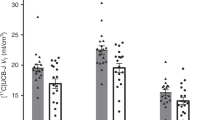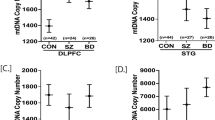Abstract
Several studies suggest that decreased expression of presynaptic proteins may be characteristic of schizophrenia. We examined one such protein, synapsin, in schizophrenia and bipolar disorder. Samples of hippocampal tissue from controls (n = 13), patients with schizophrenia (n = 16), or bipolar disorder (n = 6), and suicide victims (n = 7) were used. The membrane and cytosolic fractions were analyzed by Western immunoblotting for synapsin using an antibody that detects synapsin Ia, IIa, and IIIa proteins. Synaptophysin was also measured for comparison. Total synapsin was decreased significantly in patients with schizophrenia (P = 0.034) and in bipolar disorder (P = 0.00008) as compared to controls. The synapsin/synaptophysin ratios were decreased in schizophrenia and bipolar disorder, and additionally in suicide victims (P = 0.014). Age, postmortem interval, percentage of protein extracted, and pH of brain were not different between groups. No changes in total synapsin or synaptophysin in the hippocampus were produced by injecting rats with either lithium or haloperidol for 30 days. Reductions in synapsin in both patients with schizophrenia (synapsin IIa and IIIa) and bipolar disorder (synapsin Ia, IIa and IIIa) imply that altered or reduced synaptic function in the hippocampus may be involved in these disorders.
This is a preview of subscription content, access via your institution
Access options
Subscribe to this journal
Receive 12 print issues and online access
$259.00 per year
only $21.58 per issue
Buy this article
- Purchase on Springer Link
- Instant access to full article PDF
Prices may be subject to local taxes which are calculated during checkout




Similar content being viewed by others
References
Fuller Torrey E . Surviving Schizophrenia: A Manual for Families Consumers and Providers Harperperennial Library: New York 2000
Bachus SE, Kleinman JE . The neuropathology of schizophrenia J Clin Psychiatry 1996 57 Suppl 11: 72–83
Lachman HM, Papolos DF . A molecular model for bipolar affective disorder Med Hypotheses 1995 45: 255–264
Nelson MD, Saykin AJ, Flashman LA, Riordan HJ . Hippocampal volume reduction in schizophrenia as assessed by magnetic resonance imaging: a meta-analytic study Arch Gen Psychiatry 1998 55: 433–440
Swayze VW, Andreasen NC, Alliger RJ, Ehrhardt JC, Yuh WT . Structural brain abnormalities in bipolar affective disorder. Ventricular enlargement and focal signal hyperintensities Arch Gen Psychiatry 1990 47: 1054–1059
Swayze VW, Andreasen NC, Alliger RJ, Yuh WT, Ehrhardt JC . Subcortical and temporal structures in affective disorder and schizophrenia: a magnetic resonance imaging study Biol Psychiatry 1992 31: 221–240
Owen F, Cross AJ, Crow TJ, Longden A, Poulter M, Riley GJ . Increased dopamine-receptor sensitivity in schizophrenia Lancet 1978 2: 223–226
Deakin JF, Simpson MD . A two-process theory of schizophrenia: evidence from studies in post-mortem brain J Psychiatr Res 1997 31: 277–295
Weinberger DR . Implications of normal brain development for the pathogenesis of schizophrenia Arch Gen Psychiatry 1987 44: 660–669
Torrey EF, Yolken RH, Winfrey CJ . Cytomegalovirus antibody in cerebrospinal fluid of schizophrenic patients detected by enzyme immunoassay Science 1982 216: 892–894
Wright P, Gill M, Murray RM . Schizophrenia: genetics and the maternal immune response to viral infection Am J Med Genet 1993 48: 40–46
Keshavan MS, Anderson S, Pettegrew JW . Is schizophrenia due to excessive synaptic pruning in the prefrontal cortex? The Feinberg hypothesis revisited J Psychiatr Res 1994 28: 239–265
Horrobin DF . The membrane phospholipid hypothesis as a biochemical basis for the neurodevelopmental concept of schizophrenia Schizophr Res 1998 30: 193–208
Harrison PJ . The neuropathology of schizophrenia. A critical review of the data and their interpretation Brain 1999 122: 593–624
Browning MD, Dudek EM, Rapier JL, Leonard S, Freedman R . Significant reductions in synapsin but not synaptophysin specific activity in the brains of some schizophrenics Biol Psychiatry 1993 34: 529–535
Young CE, Arima K, Xie J, Hu L, Beach TG, Falkai P et al. SNAP-25 deficit and hippocampal connectivity in schizophrenia Cereb Cortex 1998 8: 261–268
Eastwood SL, Burnet PW, Harrison PJ . Altered synaptophysin expression as a marker of synaptic pathology in schizophrenia Neuroscience 1995 66: 309–319
Eastwood SL, Harrison PJ . Decreased synaptophysin in the medial temporal lobe in schizophrenia demonstrated using immunoautoradiography Neuroscience 1995 69: 339–343
Eastwood SL, Harrison PJ . Detection and quantification of hippocampal synaptophysin messenger RNA in schizophrenia using autoclaved, formalin-fixed, paraffin wax-embedded sections Neuroscience 1999 93: 99–106
Eastwood SL, Cairns NJ, Harrison PJ . Synaptophysin gene expression in schizophrenia. Investigation of synaptic pathology in the cerebral cortex Br J Psychiatry 2000 176: 236–242
Vawter MP, Howard AL, Hyde TM, Kleinman JE, Freed WJ . Alterations of hippocampal secreted N-CAM in bipolar disorder and synaptophysin in schizophrenia Mol Psychiatry 1999 4: 467–475
Mirnics K, Middleton FA, Marquez A, Lewis DA, Levitt P . Molecular characterization of schizophrenia viewed by microarray analysis of gene expression in prefrontal cortex Neuron 2000 28: 53–67
Hilfiker S, Pieribone VA, Czernik AJ, Kao HT, Augustine GJ, Greengard P . Synapsins as regulators of neurotransmitter release Philos Trans R Soc Lond B Biol Sci 1999 354: 269–279
Sudhof TC, Czernik AJ, Kao HT, Takei K, Johnston PA, Horiuchi A et al. Synapsins: mosaics of shared and individual domains in a family of synaptic vesicle phosphoproteins Science 1989 245: 1474–1480
Hosaka M, Sudhof TC . Synapsin III, a novel synapsin with an unusual regulation by Ca2+ J Biol Chem 1998 273: 13371–13374
Kao HT, Porton B, Czernik AJ, Feng J, Yiu G, Haring M et al. A third member of the synapsin gene family Proc Natl Acad Sci USA 1998 95: 4667–4672
Gill M, Vallada H, Collier D, Sham P, Holmans P, Murray R et al. A combined analysis of D22S278 marker alleles in affected sib-pairs: support for a susceptibility locus for schizophrenia at chromosome 22q12. Schizophrenia Collaborative Linkage Group (Chromosome 22) Am J Med Genet 1996 67: 40–45
Myles-Worsley M, Coon H, McDowell J, Brenner C, Hoff M, Lind B et al. Linkage of a composite inhibitory phenotype to a chromosome 22q locus in eight Utah families Am J Med Genet 1999 88: 544–550
Bachus SE, Hyde TM, Akil M, Weickert CS, Vawter MP, Kleinman JE . Neuropathology of suicide. A review and an approach Ann NY Acad Sci 1997 836: 201–219
Inskip HM, Harris EC, Barraclough B . Lifetime risk of suicide for affective disorder, alcoholism and schizophrenia Br J Psychiatry 1998 172: 35–37
Vawter MP, Cannon-Spoor HE, Hemperly JJ, Hyde TM, VanderPutten DM, Kleinman JE et al. Abnormal expression of cell recognition molecules in schizophrenia Exp Neurol 1998 149: 424–432
Pieribone VA, Shupliakov O, Brodin L, Hilfiker-Rothenfluh S, Czernik AJ, Greengard P . Distinct pools of synaptic vesicles in neurotransmitter release Nature 1995 375: 493–497
Hilfiker S, Pieribone VA, Nordstedt C, Greengard P, Czernik AJ . Regulation of synaptotagmin I phosphorylation by multiple protein kinases J Neurochem 1999 73: 921–932
Hershman KM, Fleming WW, Taylor DA . A quantitative method for assessing protein abundance using enhanced chemiluminescence Biotechniques 1993 15: 790 792 794
Suneja SK, Potashner SJ . Quantification of a neurotrophin receptor from submilligram quantities of brain tissue using western blotting Brain Res Brain Res Protoc 1998 3: 88–93
Goldsworthy SM, Goldsworthy TL, Sprankle CS, Butterworth BE . Variation in expression of genes used for normalization of Northern blots after induction of cell proliferation Cell Prolif 1993 26: 511–518
Weisinger G, Gavish M, Mazurika C, Zinder O . Transcription of actin, cyclophilin and glyceraldehyde phosphate dehydrogenase genes: tissue- and treatment-specificity Biochim Biophys Acta 1999 1446: 225–232
Harrison PJ, Eastwood SL . Preferential involvement of excitatory neurons in medial temporal lobe in schizophrenia Lancet 1998 352: 1669–1673
Ho L, Guo Y, Spielman L, Petrescu O, Haroutunian V, Purohit D et al. Altered expression of a-type but not b-type synapsin isoform in the brain of patients at high risk for Alzheimer's disease assessed by DNA microarray technique Neurosci Lett 2001 298: 191–194
Grebb JA, Greengard P . An analysis of synapsin II, a neuronal phosphoprotein, in postmortem brain tissue from alcoholic and neuropsychiatrically ill adults and medically ill children and young adults Arch Gen Psychiatry 1990 47: 1149–1156
Perdahl E, Wu WC, Browning MD, Winblad B, Greengard P . Protein III, a neuron-specific phosphoprotein: variant forms found in human brain Neurobehav Toxicol Teratol 1984 6: 425–431
Walaas SI, Browning MD, Greengard P . Synapsin Ia, synapsin Ib, protein IIIa, and protein IIIb, four related synaptic vesicle-associated phosphoproteins, share regional and cellular localization in rat brain J Neurochem 1988 51: 1214–1220
Acknowledgements
We wish to thank Bruce Ladenheim for dissection of hippocampus from rat brain and Drs HT Kao and Paul Greengard, Rockefeller University, for synapsin antibody G304, and additional immunoblots. Dr Mary Herman, Clinical Brain Disorders Branch, NIMH, Bethesda, MD assisted with providing the human hippocampus samples used in this study. Generous support was received from the William Lion Penzner Foundation (MPV).
Author information
Authors and Affiliations
Corresponding author
Rights and permissions
About this article
Cite this article
Vawter, M., Thatcher, L., Usen, N. et al. Reduction of synapsin in the hippocampus of patients with bipolar disorder and schizophrenia. Mol Psychiatry 7, 571–578 (2002). https://doi.org/10.1038/sj.mp.4001158
Received:
Revised:
Accepted:
Published:
Issue Date:
DOI: https://doi.org/10.1038/sj.mp.4001158
Keywords
This article is cited by
-
Alterations in brain synaptic proteins and mRNAs in mood disorders: a systematic review and meta-analysis of postmortem brain studies
Molecular Psychiatry (2022)
-
Calpains as novel players in the molecular pathogenesis of spinocerebellar ataxia type 17
Cellular and Molecular Life Sciences (2022)
-
Covariate-adjusted multiple testing in genome-wide association studies via factorial hidden Markov models
TEST (2021)
-
Identifying novel associations in GWAS by hierarchical Bayesian latent variable detection of differentially misclassified phenotypes
BMC Bioinformatics (2020)
-
Synaptic loss in schizophrenia: a meta-analysis and systematic review of synaptic protein and mRNA measures
Molecular Psychiatry (2019)



